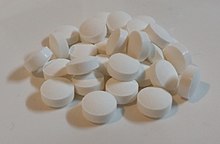
Back غلوكونات الزنك Arabic قلوکونات چینکو AZB Gluconat de zinc Catalan Glukonát zinečnatý Czech Zinkgluconat German Zinka glukonato Esperanto گلوکونات روی Persian Sinkkiglukonaatti Finnish Cink glukonat Serbo-Croatian Cink glukonat Serbian

| |
| Names | |
|---|---|
| Other names
zincum gluconicum
| |
| Identifiers | |
3D model (JSmol)
|
|
| ChEBI | |
| ChEMBL | |
| ChemSpider | |
| DrugBank | |
| ECHA InfoCard | 100.022.489 |
| EC Number |
|
| KEGG | |
PubChem CID
|
|
| UNII | |
CompTox Dashboard (EPA)
|
|
| |
| |
| Properties | |
| C12H22O14Zn | |
| Molar mass | 455.685 g/mol |
| Melting point | 172 to 175 °C (342 to 347 °F; 445 to 448 K) |
| Pharmacology | |
| A12CB02 (WHO) | |
Except where otherwise noted, data are given for materials in their standard state (at 25 °C [77 °F], 100 kPa).
| |

Zinc gluconate is the zinc salt of gluconic acid. It is an ionic compound consisting of two anions of gluconate for each zinc(II) cation. Zinc gluconate is a popular form for the delivery of zinc as a dietary supplement providing 14.35% elemental zinc by weight.
Gluconic acid is found naturally, and is industrially made by the fermentation of glucose, typically by Aspergillus niger, but also by other fungi, e.g. Penicillium, or by bacteria, e.g. Acetobacter, Pseudomonas and Gluconobacter.[1] In its pure form, it is a white to off-white powder. It can also be made by electrolytic oxidation,[2] although this is a more expensive process. The advantages are a lower microbiological profile, and a more complete reaction, yielding a product with a longer shelf life.
- ^ Sumitra Ramachandran, Pierre Fontanille, Ashok Pandey and Christian Larroche (2006). "Gluconic Acid: A Review" (PDF). Food Technology and Biotechnology. 44 (2): 185–195. Retrieved 2006-12-06.
{{cite journal}}: CS1 maint: multiple names: authors list (link) - ^ Henk G.J. de Wilt (1972). "Part I: The oxidation of Glucose to Gluconic Acid". Ind. Eng. Chem. Prod. Res. Dev. 11 (4): 370. doi:10.1021/i360044a002.
© MMXXIII Rich X Search. We shall prevail. All rights reserved. Rich X Search